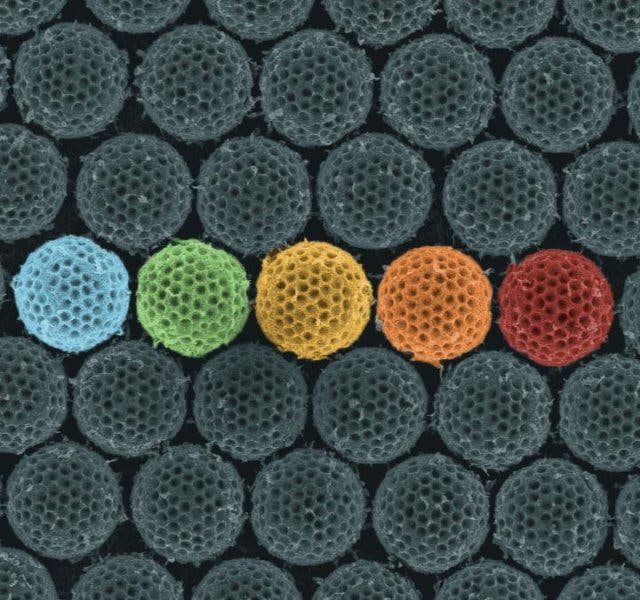Tiny, lab-produced spheres littered with nano-sized holes could form tomorrow’s anti-reflective coatings, a team of Penn State engineers reports. The material can be used to absorb a wide frequency band of light from all directions and helps to explain a previously-unknown but similar camouflage technique that the leafhopper (family Cicadellidae) uses to become virtually invisible to its predators.

Image credits Yang et al., 2017, Nature.
Leafhoppers produce a very specialized microparticle in the wild. Called brochosomes, these particles are superhydrophobic (they repel water), and the insects wipe them on their wings to keep them dry as a bone. However, the brochosomes also help the insects stay camouflaged and un-eaten, reports a new paper led by Shikuan Yang, a Munster University and Penn State Ph.D. graduate, currently a professor at Zhejiang University, China, by making them and their eggs blend in with their surroundings at the wavelengths their main predators see.
“We knew our synthetic particles might be interesting optically because of their structure,” said Tak-Sing Wong, assistant professor of mechanical engineering, the Wormely Family Early Career Professor in Engineering, and the paper’s corresponding author.
“We didn’t know, until my former postdoc [and lead author of the paper] Shikuan Yang brought it up in a group meeting, that the leaf hopper made these non-sticky coatings with a natural structure very similar to our synthetic ones. That led us to wonder how the leaf hopper used these particles in nature.”
No light, no fight
The team didn’t manage to find any mention of the leafhopper’s use of brochosomes as camouflage in the scientific literature. However, the particles are strikingly similar to the microspheres the team was working on in the lab. The pits on the surface of the synthetic spheres are very close in size to the wavelength of light, and so capture up to 99% of it in a spectrum ranging from ultraviolet to near-infrared. In effect, the spheres act as a metamaterial that could be used in a cloaking device over this spectrum, since picking up on reflections is how the whole ‘seeing’ thing works — both for our eyes and man-made devices.
This striking similarity prompted the team to check if the leafhopper’s brochosomes work the same way.
“The problem is that in the field, these leaf hoppers produce very little of this product, and it is very hard to collect,” Wong said. “But we had already produced large quantities of these structures in the lab, enough to put inside a machine to look at their optical properties.”
The team’s paper notes that simulations of insect vision revealed the leafhoppers very likely employ brochosomes as a camouflage coating to hide from predators. Antireflective coatings are very rare in nature, but there are other cases of animals employing them to remain hidden: the eyes of moths, for example, are covered in anti-reflective nanostructures so that predators won’t see them at night.
[Read more: 10 Fantastic Animals that use Bark Camouflage]
Apart from explaining one previously-unknown camouflage strategy, the microspheres have great potential in their own right.They could be applied as an antireflective coating in sensors and cameras to keep unwanted light, reflections, and glare from hitting the lens — and thus making the images crisper. Such a technology would greatly boost the image fidelity and effective range of our telescopes, for example.

Image credits Succo / Pixabay.
Another promising use is in the field of solar power. A coating of synthetic brochosomes applied to a solar cell would increase light capture across the spectrum and absorb light from every incoming angle, i.e. preventing rays from reflecting. This would drive energy production up while lowering costs, since the devices won’t need to track the sun at all times. Judging from the financing, part of it being supplied by the Defense Advanced Reseach Projects Agency, DARPA, we might even see some military applications — maybe a wide-spectrum cloaking device? Time will tell.
The team’s microspheres are constructed mostly through electrochemical deposition in a complicated five-step process. The process can easily be scaled-up however, according to the team, and can employ many different materials — from gold and silver to manganese oxide, even conductive polymers — to create the artificial brochosomes. Each brings different advantages to bear in the process.
“For example, manganese oxide is a very popular material used in supercapacitors and batteries. Because of its high surface area, this particle could make a good battery electrode and allow a higher rate of chemical reaction to take place,” Wong explains.
“This paper is more of a fundamental study,” he adds. “In the future, we may try to extend the structure to longer wavelengths. If we made the structure a little larger, could it absorb longer electromagnetic waves such as mid-infrared and open up further applications in sensing and energy harvesting?”
The paper “Ultra-antireflective synthetic brochosomes” has been published in the journal Nature.



